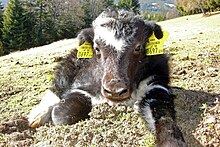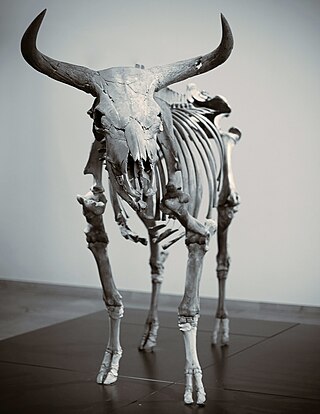
The aurochs is an extinct cattle species, considered to be the wild ancestor of modern domestic cattle. With a shoulder height of up to 180 cm (71 in) in bulls and 155 cm (61 in) in cows, it was one of the largest herbivores in the Holocene; it had massive elongated and broad horns that reached 80 cm (31 in) in length.
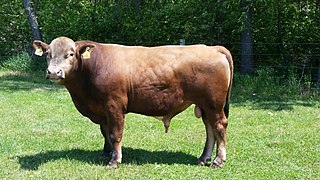
Beefalo constitute a hybrid offspring of domestic cattle, usually a male in managed breeding programs, and the American bison, usually a female in managed breeding programs. The breed was created to combine the characteristics of both animals for beef production.

The zebu, sometimes known in the plural as indicine cattle, Camel cow or humped cattle, is a species or subspecies of domestic cattle originating in South Asia. Zebu, like many Sanga cattle breeds, differs from taurine cattle by a fatty hump on their shoulders, a large dewlap, and sometimes drooping ears. They are well adapted to withstanding high temperatures and are farmed throughout the tropics.

Bovines comprise a diverse group of 10 genera of medium to large-sized ungulates, including cattle, bison, African buffalo, water buffalos, and the four-horned and spiral-horned antelopes. The evolutionary relationship between the members of the group is still debated, and their classification into loose tribes rather than formal subgroups reflects this uncertainty. General characteristics include cloven hooves and usually at least one of the sexes of a species having true horns. The largest extant bovine is the gaur.

Bos is a genus of bovines, which includes, among others, wild and domestic cattle.
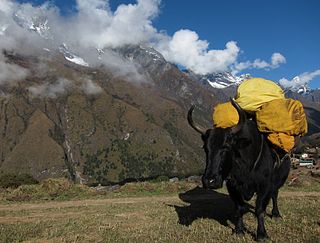
A dzo is a hybrid between the yak and domestic cattle. The word dzo technically refers to a male hybrid, while a female is known as a dzomo or zhom. In Mongolian, it is called a khainag (хайнаг). There is also the English language portmanteau term of yattle, a combination of the words yak and cattle, as well as yakow, a combination of the words yak and cow.

The Heck or Munich-Berlin is a German breed or type of domestic cattle. It was bred in the 1920s by Heinz and Lutz Heck in an attempt to breed back the extinct aurochs. Controversy revolves around methodology and success of the programme. There are considerable differences between Heck cattle and the aurochs in build, height, and body proportions. Furthermore, there are other cattle breeds which resemble their wild ancestors at least as much as Heck cattle.

The gayal, also known as the Drung ox or mithun, is a large domestic cattle distributed in Northeast India, Bangladesh, Myanmar and in Yunnan, China.

The banteng, also known as tembadau, is a species of wild bovine found in Southeast Asia.
The yakalo is a cross of the yak and the American bison. It was produced by hybridisation experiments in the 1920s, when crosses were made between yak bulls and both pure bison cows and bison-cattle hybrid cows. As with many other inter-specific crosses, only female hybrids were found to be fertile. Few of the hybrids survived, and the experiments were discontinued in 1928.

A bovid hybrid is the hybrid offspring of members of two different species of the bovid family. There are 143 extant species of bovid, and the widespread domestication of several species has led to an interest in hybridisation for the purpose of encouraging traits useful to humans, and to preserve declining populations. Bovid hybrids may occur naturally through undirected interbreeding, traditional pastoral practices, or may be the result of modern interventions, sometimes bringing together species from different parts of the world.

The tribe Bovini or wild cattle are medium to massive bovines that are native to Eurasia, North America, and Africa. These include the enigmatic, antelope-like saola, the African and Asiatic buffalos, and a clade that consists of bison and the wild cattle of the genus Bos. Not only are they the largest members of the subfamily Bovinae, they are the largest species of their family Bovidae. The largest species is the gaur, weighing up to 1,500 kg (3,300 lb).

Sanga cattle is the collective name for indigenous cattle of some regions in Africa. They are sometimes identified as a subspecies with the scientific name Bos taurus africanus. Their history of domestication and their origins in relation to taurine cattle, zebu cattle (indicine), and native African varieties of the ancestral aurochs are a matter of debate. "African taurine", "sanga", "zenga", "sheko", "African indicine" are all sub-groups of Sanga cattle.

The Indian aurochs is an extinct subspecies of aurochs that inhabited West Asia and the Indian subcontinent from the Late Pleistocene until its eventual extinction during the South Asian Stone Age. With no remains younger than 3,800 YBP ever recovered, the Indian aurochs was the first of the three aurochs subspecies to become extinct; the Eurasian aurochs and the North African aurochs persevered longer, with the latter bring known by the Roman Empire, and the former surviving until the mid-17th century in Central Europe.

Cattle are large, domesticated, bovid ungulates widely kept as livestock. They are prominent modern members of the subfamily Bovinae and the most widespread species of the genus Bos. Mature female cattle are called cows and mature male cattle are bulls. Young female cattle are called heifers, young male cattle are oxen or bullocks, and castrated male cattle are known as steers.

Yak butter is butter made from the milk of the domestic yak. Many herder communities in China, India, Mongolia, Nepal, Gilgit-Baltistan Pakistan and Tibet produce and consume dairy products made from yak's milk, including butter. Whole yak's milk has about twice the fat content of whole cow's milk, producing a butter with a texture closer to cheese. It is a staple food product and trade item for herder communities in south Central Asia and the Tibetan Plateau.
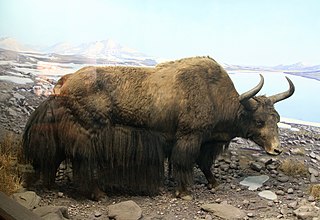
The wild yak is a large, wild bovine native to the Himalayas. It is the ancestor of the domestic yak.
Turano-Mongolian cattle are a group of taurine cattle that are found in Northern and Eastern Asia. They are morphologically and genetically distinct from the Near-Eastern group of taurine cattle, from which European cattle are descended; they may have been domesticated independently.
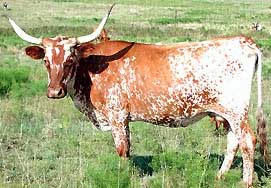
Bovina is a subtribe of the Bovini tribe that generally includes the two living genera, Bison and Bos. However, this dichotomy has been challenged recently by molecular work that suggests that Bison should be regarded as a subgenus of Bos. Wild bovinans can be found naturally in North America and Eurasia.




